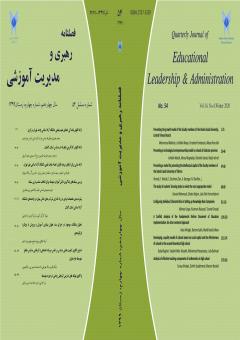شناسایی زمینههای بهکارگیری هوش مصنوعی در آموزش: پژوهش کیفی
محورهای موضوعی : آموزش و پرورش
1 - استادیار گروه علوم تربیتی، دانشکده علوم انسانی، دانشگاه بوعلی سینا، همدان، ایران.
کلید واژه:
چکیده مقاله :
هدف: در جامعه امروزی فناوریهای هوش مصنوعی به سرعت در حال پیشرفت هستند و تحولات عمیقی را در تمام جنبههای زندگی انسان بخصوص حوزه آموزش ایجاد کردهاند پژوهش حاضر با هدف شناسایی زمینههای بهکارگیری هوش مصنوعی در آموزش انجام شده است.
روش: پژوهش حاضر با رویکرد کیفی و روش فراترکیب انجام شده است. جامعه پژوهش شامل کلیه مقالهها به تعداد1500بوده که از این میان براساس بررسی عنوان، چکیده و محتوای سند، 37 سند انتخاب و تحلیل شد. به منظور تجزیه و تحلیل دادهها، از روش کدگذاری استفاده شد بدین ترتیب که ابتدا کدگذاری باز(117 کد)، کدهای محوری(19 کد) و سپس با مشخص کردن کدهای انتخابی(4 کد) زمینههای به کارگیری هوش مصنوعی در آموزش شناسایی گردید.
یافته ها: یافتههای پژوهش، زمینههای بهکارگیری هوش مصنوعی در آموزش را در 4 دسته، تدریس، یادگیری، ارزیابی و مدیریت نشان داد، تدریس شامل: افزایش توانایی مربیان برای تدریس، ارائه محتوای آموزشی سفارشی، حمایت از توسعه حرفهای مربیان، تدریس شخصی سازی شده، معلم هوشمند، آموزش هوشمند؛ یادگیری شامل: یادگیری شخصیسازی شده/ تطبیقی، ربابتهای گفتگویی، یادگیری هوشمند، بسترهای هوشمند برای خودیادگیری، محیط یادگیری اکتشافی، مشاوره فردی به فراگیران؛ ارزیابی شامل: نمرهدهی خودکار به تکالیف و امتحانات، کنترل فرایند یادگیری، پیش بینی عملکرد فراگیران، ارزیابی تدریس، بازخوردهای شخصی سازی شده؛ و مدیریت شامل: پردیس هوشمند، به اشتراکگذاری و ذخیره حجم زیادی از دادهها، مدیریت زمان، همکاریهای بینالمللی بین نظامهای آموزشی در بستر هوش مصنوعی و خودکارسازی وظابف اداری می باشد.
نتیجه گیری: پذیرش و استفاده از هوش مصنوعی در آموزش، فرصتهای چشمگیری را برای ارتقای نظامهای آموزشی فراهم میکند.
Purpose: In today's society, artificial intelligence technologies are developing rapidly and have created profound changes in all aspects of human life, especially in the field of education.
Methods: The current research was conducted with a qualitative approach and a Meta-synthesis method. The research population included all 1,500 articles, of which 37 documents were selected and analyzed based on the review of the title, abstract and content of the document. In order to analyze the data, the coding method was used in such a way that open coding (117 codes), central codes (19 codes) and then by specifying selected codes (4 codes) the fields of applying artificial intelligence in education were determined.
Findings: The findings of the research showed the fields of applying artificial intelligence in education in 4 categories, teaching, learning, evaluation and management, teaching includes: increasing the ability of educators to teach, providing customized educational content, supporting the professional development of educators, personalized teaching, teacher Smart, smart education; Learning includes: personalized/adaptive learning, dialog bots, smart learning, smart platforms for self-learning, exploratory learning environment, individual counseling to learners; Evaluation includes: automatic grading of assignments and exams, learning process control, learner performance prediction, teaching evaluation, adaptive/personalized feedback; And management includes: smart campus, sharing and storing a large amount of data, time management, international cooperation between educational systems in the context of artificial intelligence and automation of administrative tasks such as admission and registration, attendance and absence, etc.
Conclusion The adoption and use of artificial intelligence in education offers significant opportunities to improve educational systems

